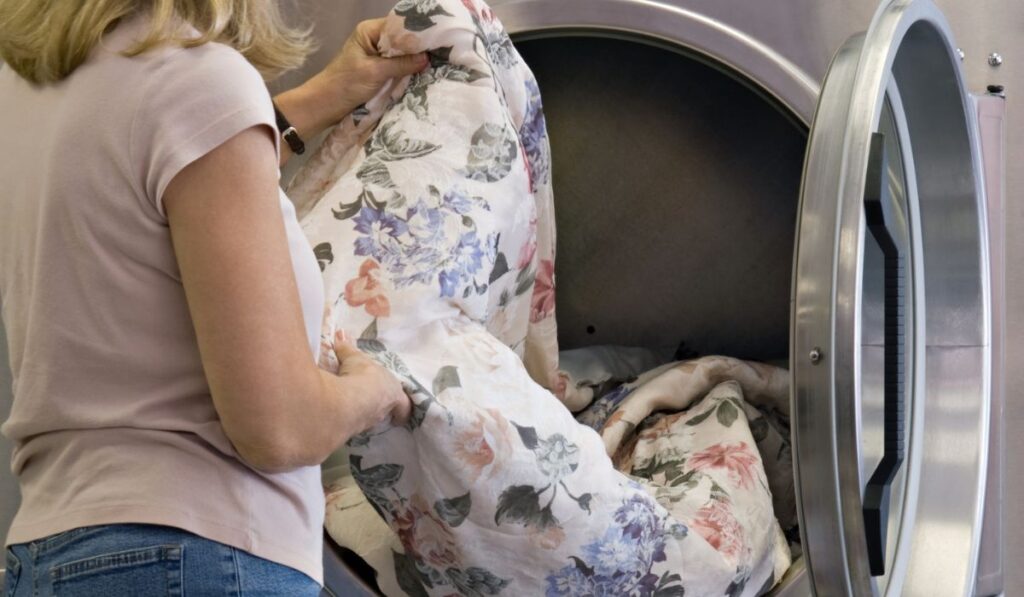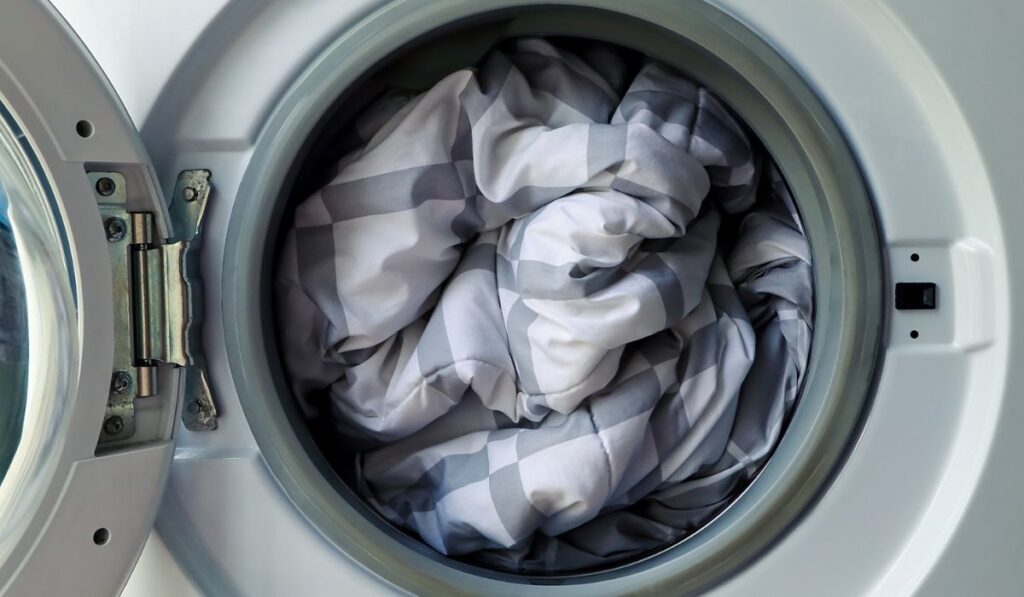A comforter is key to getting the restful, comfortable, deep sleep that you deserve. But in order to get the best results from your comforter, it should be crisp and clean. You might think that a freshly purchased comforter is ready to go, but is it actually as clean as it seems?
You should wash your new comforter. New comforters may contain dust mites, chemicals, and other allergens that accumulate while they’re sitting in stores or during transit. After you wash your comforter, make sure to dry it well to avoid bacteria, fungi, mold, or mildew.
Let’s take a closer look at how to wash, dry, and maintain your brand new comforter. With these tips and tricks, you’ll be sleeping like a baby in no time.
Does a New Comforter Need to Be Washed Before Use?

You’ve just bought a new comforter and understandably eager to try it out, but the question is: Should you wash it before using it for the very first time? Yes; your new comforter needs washing, no matter its quality or condition upon arrival.
This is because the comforter can accumulate dirt and germs during transit and storage, and it also has residual chemicals that it collects during the manufacturing process.
New comforters also have a characteristic smell, which may not be good if you suffer from allergies or respiratory issues. Washing it before use ensures that this odor will be gone and replaced with the pleasant smell of freshly laundered linens.
How to Wash Your Comforter
Besides washing your comforter when it’s brand new, you should also wash it on a somewhat regular basis to keep it fresh and clean.
As you sleep, your comforter picks up dust mites, dead skin cells, and sweat every night. When you leave these elements to accumulate, you can suffer from allergic reactions.
You need to wash your comforter regularly to prevent this buildup. Proper washing maintains the fluff while at the same time reducing bacteria, dust mites, and other allergens.
Before Washing
Before washing your comforter, check the manufacturer’s instructions on the care tag. The instructions explain the best way to care for your specific comforter and how to clean it. You can also make small repairs like sewing up any holes and tightening loose seams, if necessary.
Don’t forget to remove stains to maintain the comforter’s vibrant color. You can use a mixture of cold water and baking powder as a stain remover. Apply the mixture to the stain, let it rest for a few minutes, then wipe it off using a damp cloth. For fresh stains, you can simply use a damp cloth with no stain remover.
The care tag on a comforter should indicate whether your comforter can only be dry-cleaned or machine-washed. It also indicates the type of detergent to use, recommended temperature settings, whether you can use bleach on the comforter, and the best drying cycle.
Washing the Comforter
Machine Washing
If the manufacturer of your comforter recommends machine washing, then you have to use a washing machine. First, make sure your comforter can fit into the machine.
If you have a smaller size like full, twin XL, or twin, it’ll likely fit just fine. Larger sizes, such as California king, king, and queen, might not fit. Hand washing can be done instead. Don’t force a comforter into a machine washer.
The comforter should be evenly distributed inside the washer. If it’s tightly packed, the machine can get damaged and the comforter won’t be washed very well.
If you have a large comforter, you can take it to a local dry cleaner or laundromat. If you have the time, hand washing a big comforter can save you some money.
When using the washer, select a cool water setting and a delicate cycle to make sure the machine takes it easy on your comforter. Also, remember to add one extra rinsing cycle to better remove allergens, bacteria, and dust mites from the comforter. Don’t use a harsh detergent.
A gentle detergent won’t strip the down’s soft feathers or the natural oils that maintain their insulation. If you use a strong detergent, your comforter could become lumpy and flat. We cover how to fix a lumpy comforter in our other post, so check it out.
Once you’ve completed the cleaning cycle, you can use the dryer. If you don’t have one, use hot water for the wash cycle. All dust mites will be killed by water at a temperature above 130 degrees.
To balance your washing machine and ensure even cleaning, add a few tennis balls (on Amazon) to the machine.
Hand Washing
If your comfort isn’t washing machine friendly or is too large for a washing machine, you can hand wash it. For the below steps for the proper washing of your comforter:
- Fill a bathtub with water, preferably cold. If you have a large capacity load, add some mild detergent to the water, then agitate it with your hand to get a uniform detergent-water mixture.
- Immerse the comforter fully in the water. Let it soak for about ten minutes, then wash it gently by pressing it down and swirling it around. Don’t wring it out as this can damage it and even reduce its fluff.
- Once you’re satisfied that the comforter is thoroughly clean, you can drain off water from the bathtub and press the comforter down against the bathtub’s bottom to release as much water as possible.
- Refill the bathtub with cool water, and then swirl and press the comforter until suds no longer form.
- Once you’re satisfied the comforter is adequately rinsed, you can once again drain the bathtub and press the comforter down against the bottom of the bathtub to remove excess water. You can repeat the rinsing process to completely remove the dirt and detergent.
- Hang the comforter to dry or dry it using a drying machine.
Can a Comforter Go in the Dryer?
Yes. Your comforter can go into the dryer. After washing it, it’s safe to put it in your dryer. While putting it in the dryer, add some wool dryer balls (on Amazon) or use the same tennis ball you used in the washer.
These balls accelerate the drying process because they absorb moisture. They also eliminate static charges, thus preventing the comforter from clumping.
In the absence of the wool dryer balls or tennis balls, you’ll have to remove the comforter from the dryer every 20-30 minutes, hand-fluff it, and return it to the dryer. Doing so helps the material to dry evenly by re-distributing the fill and making sure it dries back into its original shape.
The comforter should be tumble-dried on low heat, so expect it to take longer than usual to dry. Remember to check it every half hour until it’s relatively dry. You need not leave your comforter in the dryer until it dries completely.
You can take the comforter out of the dryer while it still has some moisture and move it to a sunny area to fully dry. Rotate it 90 degrees every half an hour to ensure the fill doesn’t collect in one spot. Drying it in the sun also kills any remaining dust mites.
Remember that any leftover moisture can cause mold and mildew to grow. Thorough drying also ensures the comforter stays odor-free and lofty. Just be careful not to roast the comforter at high heat, as this can damage it permanently.
If you’re concerned about disinfecting your comforter, especially if you suspect it has a high viral load, you can dry it on high heat, but for no more than 20 minutes, before switching to medium or low heat for the rest of the drying cycle. High heat will kill all dust mites and other allergens.
What Kind of Detergent Is Best for a Comforter?
Comforters are delicate products, so you need to handle them with care. Use a mild or natural detergent when washing your comforter. There are specialty laundry detergents that are formulated to wash down comforters, sleeping bags, and other down-filled products, like Downwash (on Amazon).
Avoid using powdered detergents because, unlike liquid detergents, they don’t dissolve easily. Once you’re done washing, make sure you rinse your comforter well to eliminate all traces of the detergent.
Can Down Comforters Be Washed?

Down is the perfect filling for comforters because it’s comfortable and warm. But as you continue to use your down-filled comforter, it’s bound to get dirty.
When it comes to cleaning your down-filled comforter, most experts prefer dry cleaning to prevent it from shrinking. However, that doesn’t necessarily mean you can’t wash it yourself at home.
Before you wash a down comforter, check its care tag for instructions. If the comforter is made of delicate fabric or has embellishments, it’s better to leave the cleaning to a professional.
However, if your down-filled comforter is 100% cotton, you can wash and dry it yourself. However, it’s not a simple process, so you need to plan to do it on a day that you’re free. The good news is that you won’t need to wash the comforter regularly. Washing it once a year should suffice.
Don’t use a strong detergent when washing a down comforter to prevent it from losing its fluffiness. It’s best to choose a natural, mild detergent or soap specifically formulated for down. Look for products advertised as down wash or down suds, such as this Down Wash Detergent (on Amazon).
